Chronic Illness Scenario - Type 1 Diabetes
VerifiedAdded on 2022/08/11
|8
|2057
|27
AI Summary
Contribute Materials
Your contribution can guide someone’s learning journey. Share your
documents today.

Running head: CHRONIC ILLNESS SCENARIO
CHRONIC ILLNESS SCENARIO
Name of the student:
Name of the university:
Author note:
CHRONIC ILLNESS SCENARIO
Name of the student:
Name of the university:
Author note:
Secure Best Marks with AI Grader
Need help grading? Try our AI Grader for instant feedback on your assignments.
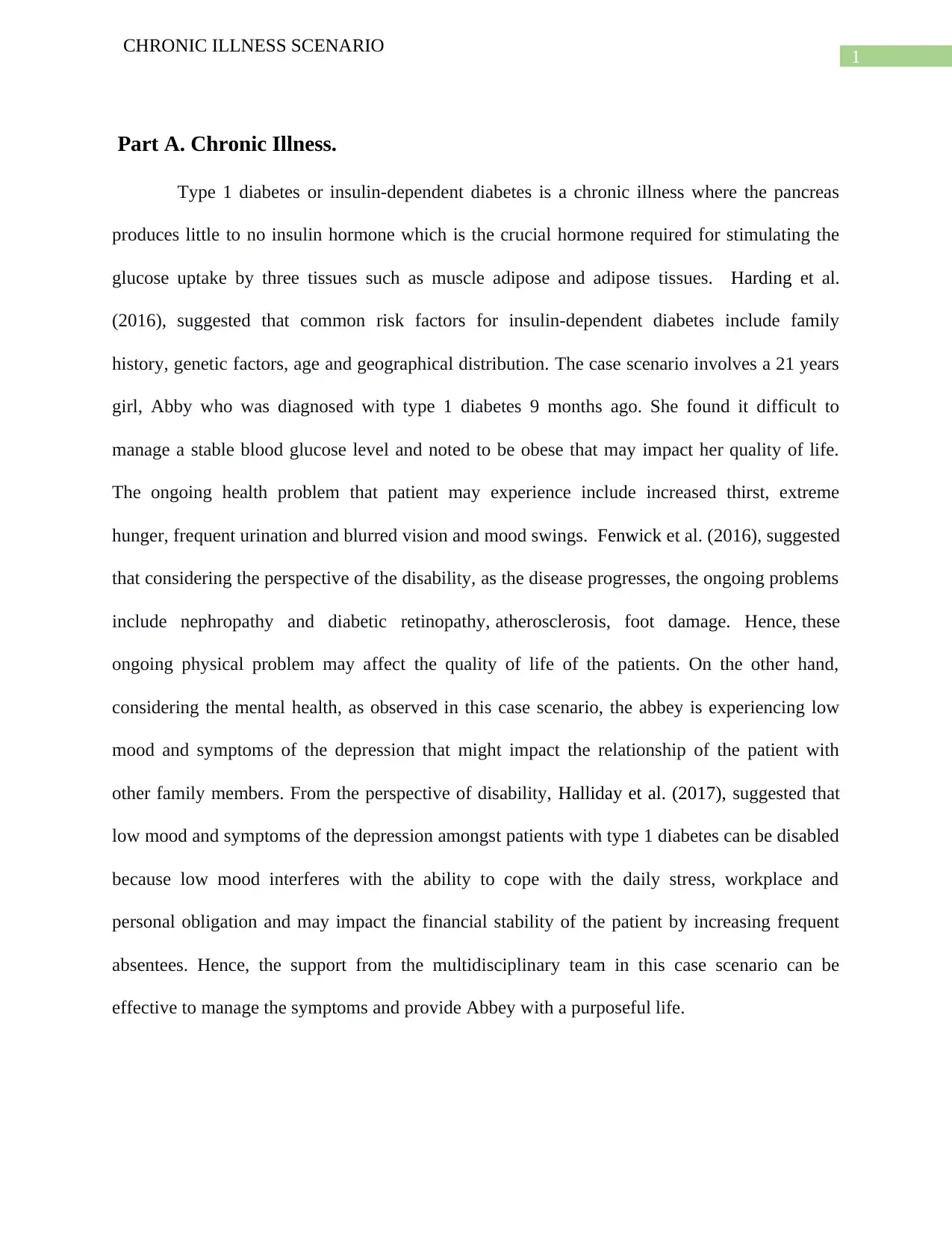
1
CHRONIC ILLNESS SCENARIO
Part A. Chronic Illness.
Type 1 diabetes or insulin-dependent diabetes is a chronic illness where the pancreas
produces little to no insulin hormone which is the crucial hormone required for stimulating the
glucose uptake by three tissues such as muscle adipose and adipose tissues. Harding et al.
(2016), suggested that common risk factors for insulin-dependent diabetes include family
history, genetic factors, age and geographical distribution. The case scenario involves a 21 years
girl, Abby who was diagnosed with type 1 diabetes 9 months ago. She found it difficult to
manage a stable blood glucose level and noted to be obese that may impact her quality of life.
The ongoing health problem that patient may experience include increased thirst, extreme
hunger, frequent urination and blurred vision and mood swings. Fenwick et al. (2016), suggested
that considering the perspective of the disability, as the disease progresses, the ongoing problems
include nephropathy and diabetic retinopathy, atherosclerosis, foot damage. Hence, these
ongoing physical problem may affect the quality of life of the patients. On the other hand,
considering the mental health, as observed in this case scenario, the abbey is experiencing low
mood and symptoms of the depression that might impact the relationship of the patient with
other family members. From the perspective of disability, Halliday et al. (2017), suggested that
low mood and symptoms of the depression amongst patients with type 1 diabetes can be disabled
because low mood interferes with the ability to cope with the daily stress, workplace and
personal obligation and may impact the financial stability of the patient by increasing frequent
absentees. Hence, the support from the multidisciplinary team in this case scenario can be
effective to manage the symptoms and provide Abbey with a purposeful life.
CHRONIC ILLNESS SCENARIO
Part A. Chronic Illness.
Type 1 diabetes or insulin-dependent diabetes is a chronic illness where the pancreas
produces little to no insulin hormone which is the crucial hormone required for stimulating the
glucose uptake by three tissues such as muscle adipose and adipose tissues. Harding et al.
(2016), suggested that common risk factors for insulin-dependent diabetes include family
history, genetic factors, age and geographical distribution. The case scenario involves a 21 years
girl, Abby who was diagnosed with type 1 diabetes 9 months ago. She found it difficult to
manage a stable blood glucose level and noted to be obese that may impact her quality of life.
The ongoing health problem that patient may experience include increased thirst, extreme
hunger, frequent urination and blurred vision and mood swings. Fenwick et al. (2016), suggested
that considering the perspective of the disability, as the disease progresses, the ongoing problems
include nephropathy and diabetic retinopathy, atherosclerosis, foot damage. Hence, these
ongoing physical problem may affect the quality of life of the patients. On the other hand,
considering the mental health, as observed in this case scenario, the abbey is experiencing low
mood and symptoms of the depression that might impact the relationship of the patient with
other family members. From the perspective of disability, Halliday et al. (2017), suggested that
low mood and symptoms of the depression amongst patients with type 1 diabetes can be disabled
because low mood interferes with the ability to cope with the daily stress, workplace and
personal obligation and may impact the financial stability of the patient by increasing frequent
absentees. Hence, the support from the multidisciplinary team in this case scenario can be
effective to manage the symptoms and provide Abbey with a purposeful life.
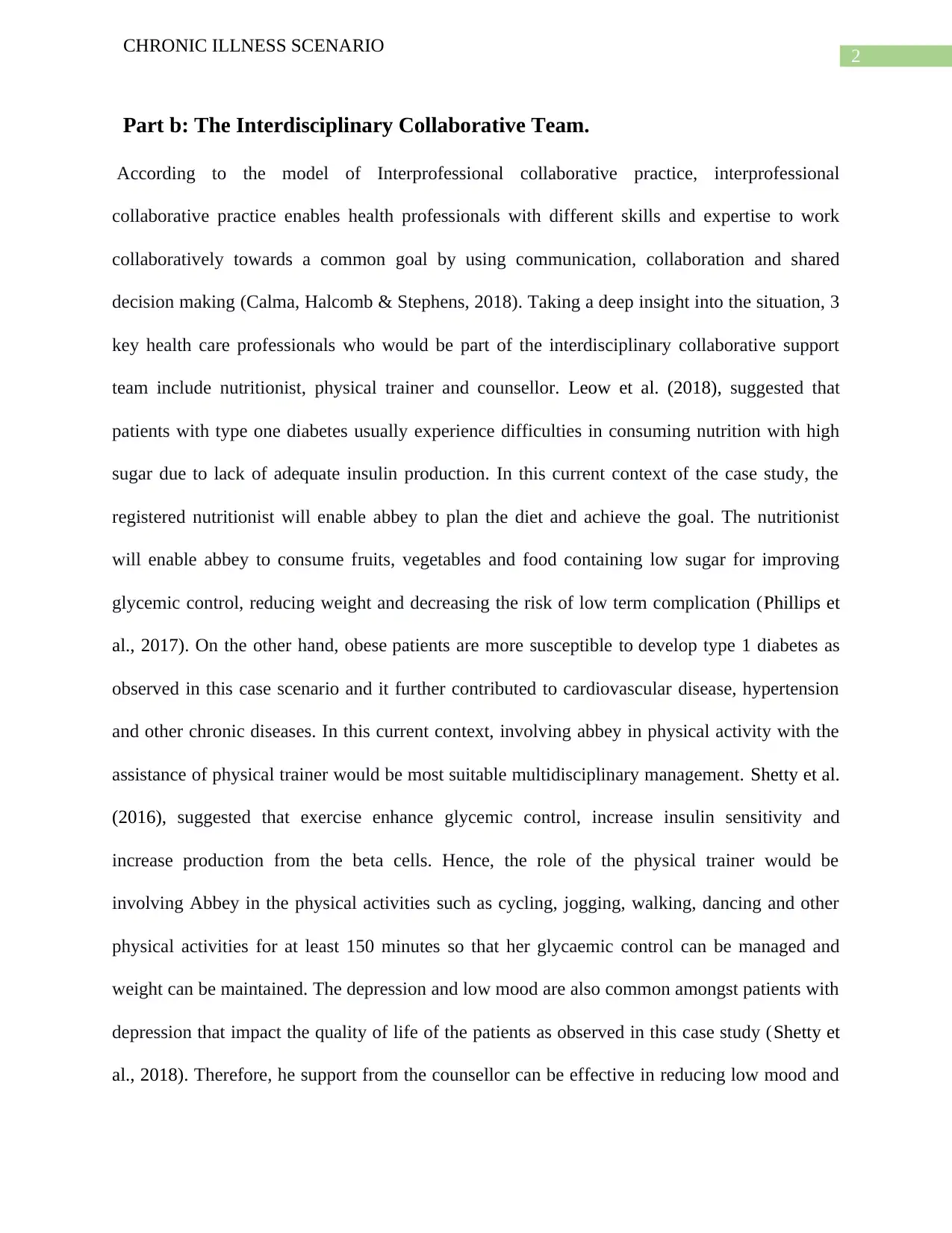
2
CHRONIC ILLNESS SCENARIO
Part b: The Interdisciplinary Collaborative Team.
According to the model of Interprofessional collaborative practice, interprofessional
collaborative practice enables health professionals with different skills and expertise to work
collaboratively towards a common goal by using communication, collaboration and shared
decision making (Calma, Halcomb & Stephens, 2018). Taking a deep insight into the situation, 3
key health care professionals who would be part of the interdisciplinary collaborative support
team include nutritionist, physical trainer and counsellor. Leow et al. (2018), suggested that
patients with type one diabetes usually experience difficulties in consuming nutrition with high
sugar due to lack of adequate insulin production. In this current context of the case study, the
registered nutritionist will enable abbey to plan the diet and achieve the goal. The nutritionist
will enable abbey to consume fruits, vegetables and food containing low sugar for improving
glycemic control, reducing weight and decreasing the risk of low term complication (Phillips et
al., 2017). On the other hand, obese patients are more susceptible to develop type 1 diabetes as
observed in this case scenario and it further contributed to cardiovascular disease, hypertension
and other chronic diseases. In this current context, involving abbey in physical activity with the
assistance of physical trainer would be most suitable multidisciplinary management. Shetty et al.
(2016), suggested that exercise enhance glycemic control, increase insulin sensitivity and
increase production from the beta cells. Hence, the role of the physical trainer would be
involving Abbey in the physical activities such as cycling, jogging, walking, dancing and other
physical activities for at least 150 minutes so that her glycaemic control can be managed and
weight can be maintained. The depression and low mood are also common amongst patients with
depression that impact the quality of life of the patients as observed in this case study (Shetty et
al., 2018). Therefore, he support from the counsellor can be effective in reducing low mood and
CHRONIC ILLNESS SCENARIO
Part b: The Interdisciplinary Collaborative Team.
According to the model of Interprofessional collaborative practice, interprofessional
collaborative practice enables health professionals with different skills and expertise to work
collaboratively towards a common goal by using communication, collaboration and shared
decision making (Calma, Halcomb & Stephens, 2018). Taking a deep insight into the situation, 3
key health care professionals who would be part of the interdisciplinary collaborative support
team include nutritionist, physical trainer and counsellor. Leow et al. (2018), suggested that
patients with type one diabetes usually experience difficulties in consuming nutrition with high
sugar due to lack of adequate insulin production. In this current context of the case study, the
registered nutritionist will enable abbey to plan the diet and achieve the goal. The nutritionist
will enable abbey to consume fruits, vegetables and food containing low sugar for improving
glycemic control, reducing weight and decreasing the risk of low term complication (Phillips et
al., 2017). On the other hand, obese patients are more susceptible to develop type 1 diabetes as
observed in this case scenario and it further contributed to cardiovascular disease, hypertension
and other chronic diseases. In this current context, involving abbey in physical activity with the
assistance of physical trainer would be most suitable multidisciplinary management. Shetty et al.
(2016), suggested that exercise enhance glycemic control, increase insulin sensitivity and
increase production from the beta cells. Hence, the role of the physical trainer would be
involving Abbey in the physical activities such as cycling, jogging, walking, dancing and other
physical activities for at least 150 minutes so that her glycaemic control can be managed and
weight can be maintained. The depression and low mood are also common amongst patients with
depression that impact the quality of life of the patients as observed in this case study (Shetty et
al., 2018). Therefore, he support from the counsellor can be effective in reducing low mood and
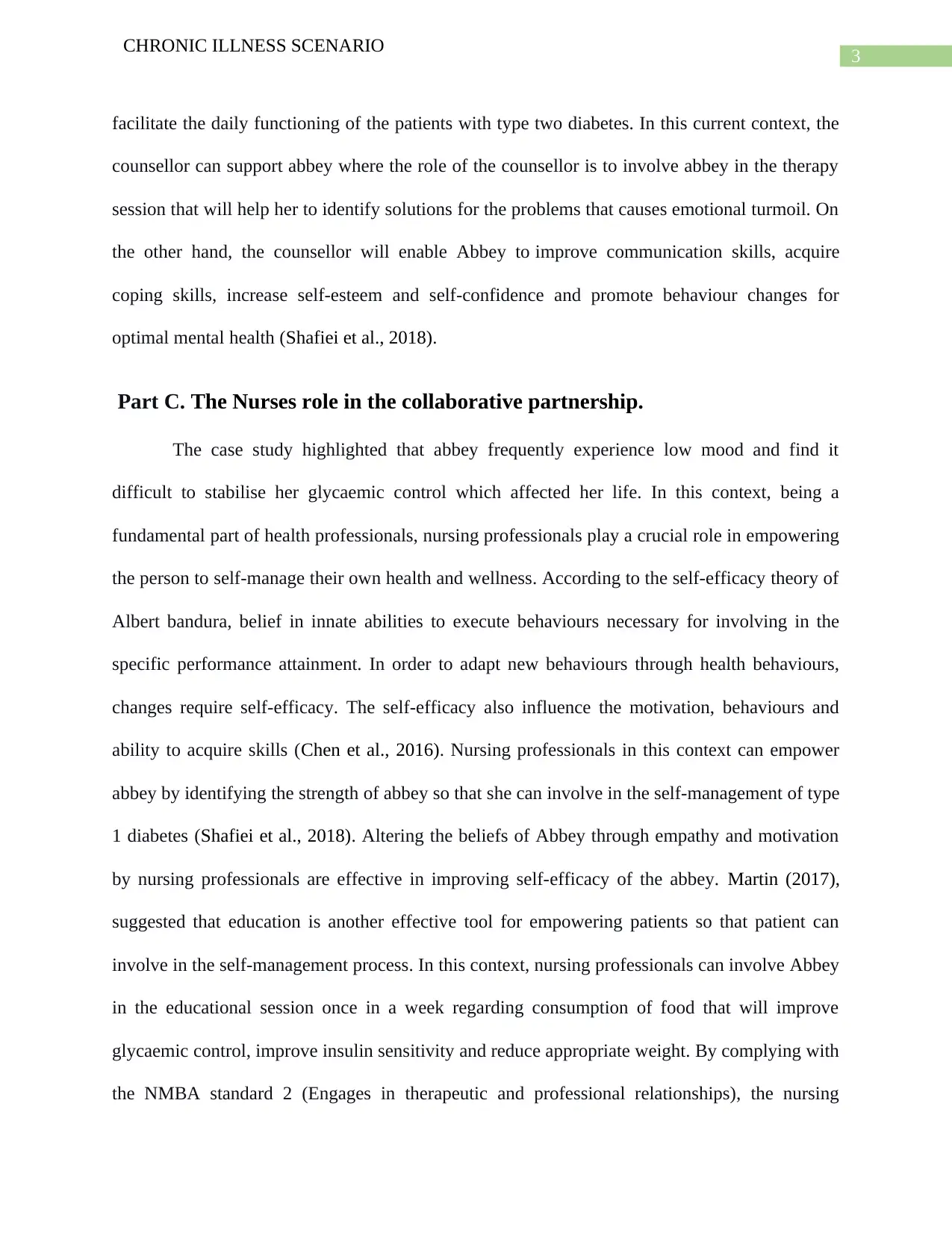
3
CHRONIC ILLNESS SCENARIO
facilitate the daily functioning of the patients with type two diabetes. In this current context, the
counsellor can support abbey where the role of the counsellor is to involve abbey in the therapy
session that will help her to identify solutions for the problems that causes emotional turmoil. On
the other hand, the counsellor will enable Abbey to improve communication skills, acquire
coping skills, increase self-esteem and self-confidence and promote behaviour changes for
optimal mental health (Shafiei et al., 2018).
Part C. The Nurses role in the collaborative partnership.
The case study highlighted that abbey frequently experience low mood and find it
difficult to stabilise her glycaemic control which affected her life. In this context, being a
fundamental part of health professionals, nursing professionals play a crucial role in empowering
the person to self-manage their own health and wellness. According to the self-efficacy theory of
Albert bandura, belief in innate abilities to execute behaviours necessary for involving in the
specific performance attainment. In order to adapt new behaviours through health behaviours,
changes require self-efficacy. The self-efficacy also influence the motivation, behaviours and
ability to acquire skills (Chen et al., 2016). Nursing professionals in this context can empower
abbey by identifying the strength of abbey so that she can involve in the self-management of type
1 diabetes (Shafiei et al., 2018). Altering the beliefs of Abbey through empathy and motivation
by nursing professionals are effective in improving self-efficacy of the abbey. Martin (2017),
suggested that education is another effective tool for empowering patients so that patient can
involve in the self-management process. In this context, nursing professionals can involve Abbey
in the educational session once in a week regarding consumption of food that will improve
glycaemic control, improve insulin sensitivity and reduce appropriate weight. By complying with
the NMBA standard 2 (Engages in therapeutic and professional relationships), the nursing
CHRONIC ILLNESS SCENARIO
facilitate the daily functioning of the patients with type two diabetes. In this current context, the
counsellor can support abbey where the role of the counsellor is to involve abbey in the therapy
session that will help her to identify solutions for the problems that causes emotional turmoil. On
the other hand, the counsellor will enable Abbey to improve communication skills, acquire
coping skills, increase self-esteem and self-confidence and promote behaviour changes for
optimal mental health (Shafiei et al., 2018).
Part C. The Nurses role in the collaborative partnership.
The case study highlighted that abbey frequently experience low mood and find it
difficult to stabilise her glycaemic control which affected her life. In this context, being a
fundamental part of health professionals, nursing professionals play a crucial role in empowering
the person to self-manage their own health and wellness. According to the self-efficacy theory of
Albert bandura, belief in innate abilities to execute behaviours necessary for involving in the
specific performance attainment. In order to adapt new behaviours through health behaviours,
changes require self-efficacy. The self-efficacy also influence the motivation, behaviours and
ability to acquire skills (Chen et al., 2016). Nursing professionals in this context can empower
abbey by identifying the strength of abbey so that she can involve in the self-management of type
1 diabetes (Shafiei et al., 2018). Altering the beliefs of Abbey through empathy and motivation
by nursing professionals are effective in improving self-efficacy of the abbey. Martin (2017),
suggested that education is another effective tool for empowering patients so that patient can
involve in the self-management process. In this context, nursing professionals can involve Abbey
in the educational session once in a week regarding consumption of food that will improve
glycaemic control, improve insulin sensitivity and reduce appropriate weight. By complying with
the NMBA standard 2 (Engages in therapeutic and professional relationships), the nursing
Secure Best Marks with AI Grader
Need help grading? Try our AI Grader for instant feedback on your assignments.
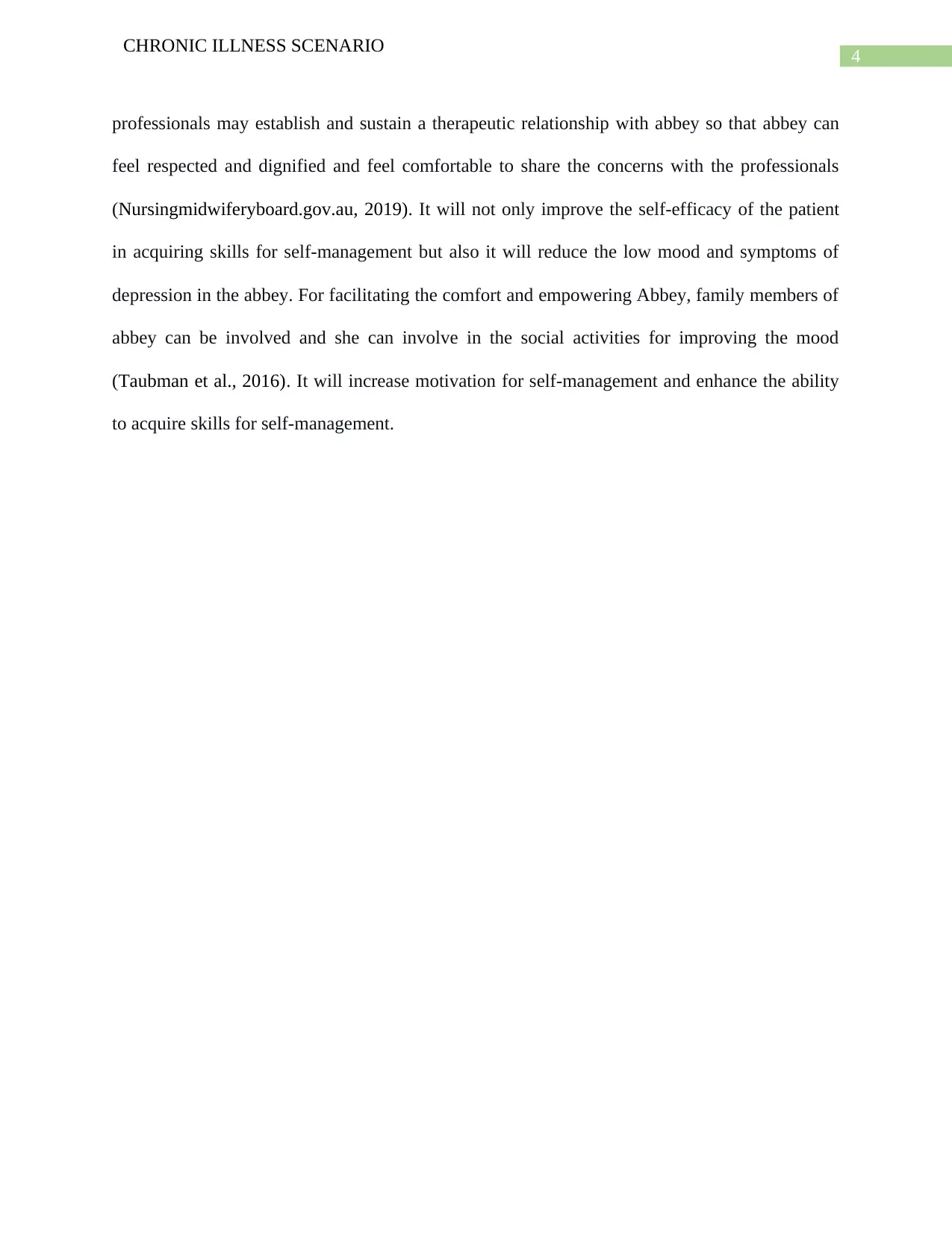
4
CHRONIC ILLNESS SCENARIO
professionals may establish and sustain a therapeutic relationship with abbey so that abbey can
feel respected and dignified and feel comfortable to share the concerns with the professionals
(Nursingmidwiferyboard.gov.au, 2019). It will not only improve the self-efficacy of the patient
in acquiring skills for self-management but also it will reduce the low mood and symptoms of
depression in the abbey. For facilitating the comfort and empowering Abbey, family members of
abbey can be involved and she can involve in the social activities for improving the mood
(Taubman et al., 2016). It will increase motivation for self-management and enhance the ability
to acquire skills for self-management.
CHRONIC ILLNESS SCENARIO
professionals may establish and sustain a therapeutic relationship with abbey so that abbey can
feel respected and dignified and feel comfortable to share the concerns with the professionals
(Nursingmidwiferyboard.gov.au, 2019). It will not only improve the self-efficacy of the patient
in acquiring skills for self-management but also it will reduce the low mood and symptoms of
depression in the abbey. For facilitating the comfort and empowering Abbey, family members of
abbey can be involved and she can involve in the social activities for improving the mood
(Taubman et al., 2016). It will increase motivation for self-management and enhance the ability
to acquire skills for self-management.
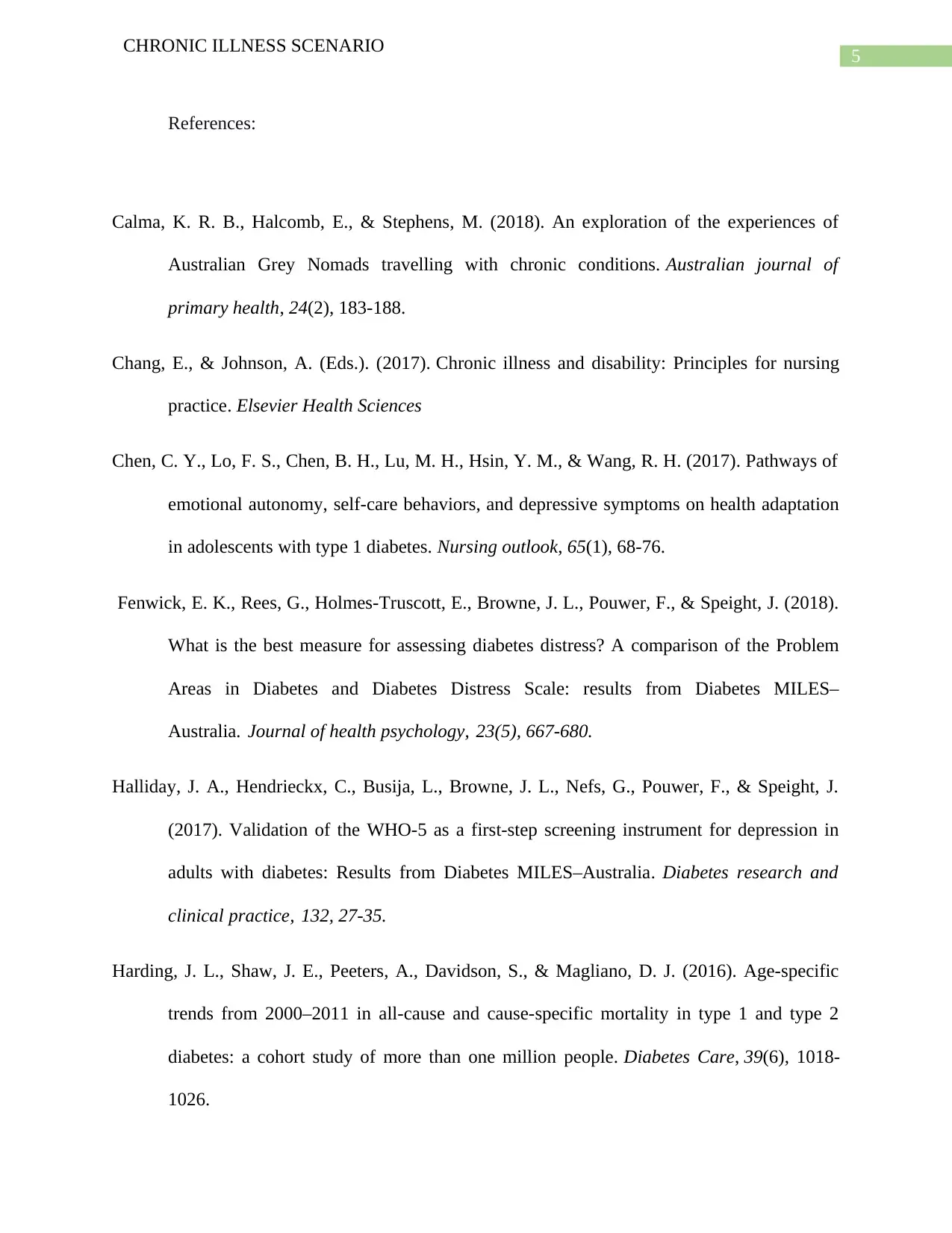
5
CHRONIC ILLNESS SCENARIO
References:
Calma, K. R. B., Halcomb, E., & Stephens, M. (2018). An exploration of the experiences of
Australian Grey Nomads travelling with chronic conditions. Australian journal of
primary health, 24(2), 183-188.
Chang, E., & Johnson, A. (Eds.). (2017). Chronic illness and disability: Principles for nursing
practice. Elsevier Health Sciences
Chen, C. Y., Lo, F. S., Chen, B. H., Lu, M. H., Hsin, Y. M., & Wang, R. H. (2017). Pathways of
emotional autonomy, self-care behaviors, and depressive symptoms on health adaptation
in adolescents with type 1 diabetes. Nursing outlook, 65(1), 68-76.
Fenwick, E. K., Rees, G., Holmes-Truscott, E., Browne, J. L., Pouwer, F., & Speight, J. (2018).
What is the best measure for assessing diabetes distress? A comparison of the Problem
Areas in Diabetes and Diabetes Distress Scale: results from Diabetes MILES–
Australia. Journal of health psychology, 23(5), 667-680.
Halliday, J. A., Hendrieckx, C., Busija, L., Browne, J. L., Nefs, G., Pouwer, F., & Speight, J.
(2017). Validation of the WHO-5 as a first-step screening instrument for depression in
adults with diabetes: Results from Diabetes MILES–Australia. Diabetes research and
clinical practice, 132, 27-35.
Harding, J. L., Shaw, J. E., Peeters, A., Davidson, S., & Magliano, D. J. (2016). Age-specific
trends from 2000–2011 in all-cause and cause-specific mortality in type 1 and type 2
diabetes: a cohort study of more than one million people. Diabetes Care, 39(6), 1018-
1026.
CHRONIC ILLNESS SCENARIO
References:
Calma, K. R. B., Halcomb, E., & Stephens, M. (2018). An exploration of the experiences of
Australian Grey Nomads travelling with chronic conditions. Australian journal of
primary health, 24(2), 183-188.
Chang, E., & Johnson, A. (Eds.). (2017). Chronic illness and disability: Principles for nursing
practice. Elsevier Health Sciences
Chen, C. Y., Lo, F. S., Chen, B. H., Lu, M. H., Hsin, Y. M., & Wang, R. H. (2017). Pathways of
emotional autonomy, self-care behaviors, and depressive symptoms on health adaptation
in adolescents with type 1 diabetes. Nursing outlook, 65(1), 68-76.
Fenwick, E. K., Rees, G., Holmes-Truscott, E., Browne, J. L., Pouwer, F., & Speight, J. (2018).
What is the best measure for assessing diabetes distress? A comparison of the Problem
Areas in Diabetes and Diabetes Distress Scale: results from Diabetes MILES–
Australia. Journal of health psychology, 23(5), 667-680.
Halliday, J. A., Hendrieckx, C., Busija, L., Browne, J. L., Nefs, G., Pouwer, F., & Speight, J.
(2017). Validation of the WHO-5 as a first-step screening instrument for depression in
adults with diabetes: Results from Diabetes MILES–Australia. Diabetes research and
clinical practice, 132, 27-35.
Harding, J. L., Shaw, J. E., Peeters, A., Davidson, S., & Magliano, D. J. (2016). Age-specific
trends from 2000–2011 in all-cause and cause-specific mortality in type 1 and type 2
diabetes: a cohort study of more than one million people. Diabetes Care, 39(6), 1018-
1026.
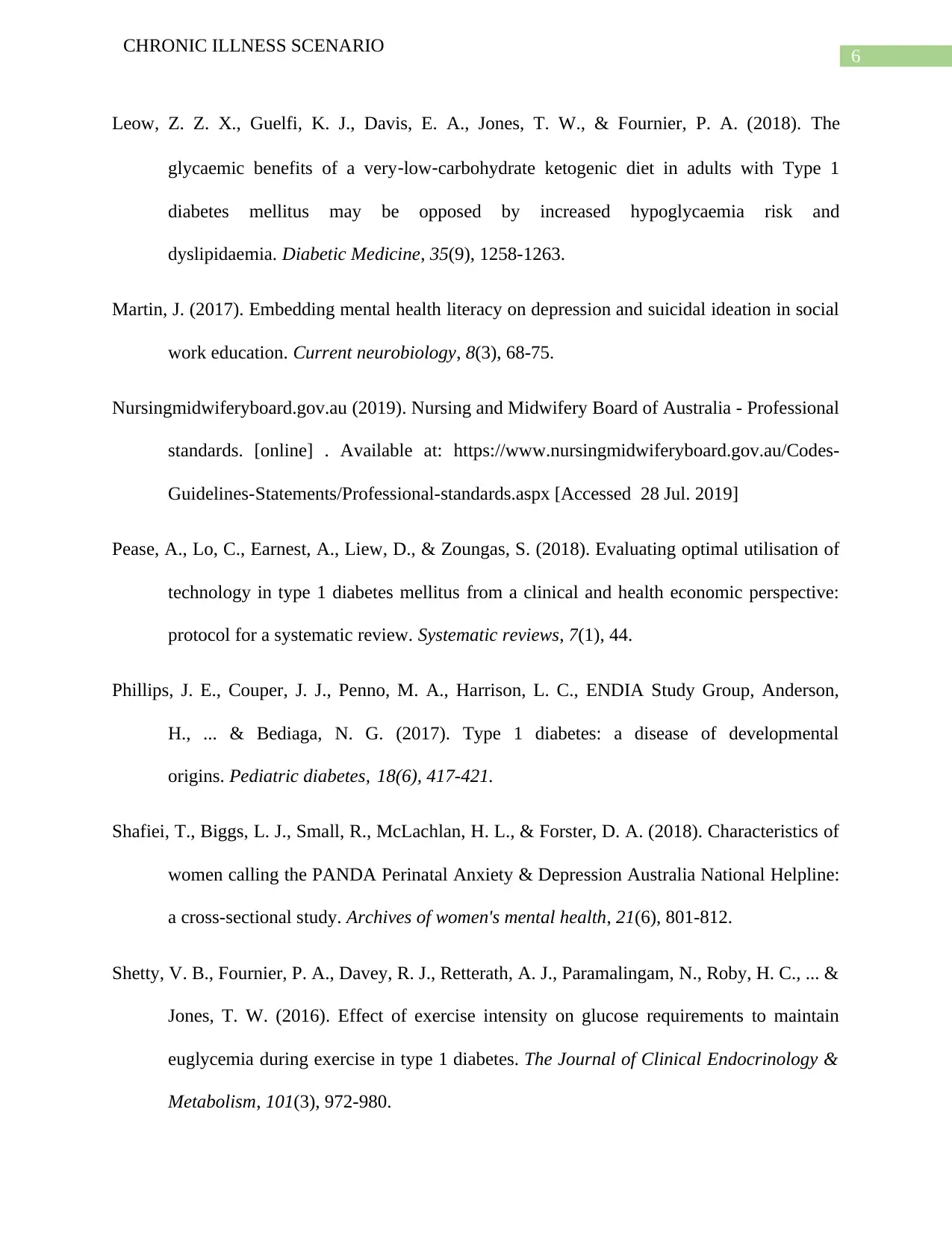
6
CHRONIC ILLNESS SCENARIO
Leow, Z. Z. X., Guelfi, K. J., Davis, E. A., Jones, T. W., & Fournier, P. A. (2018). The
glycaemic benefits of a very‐low‐carbohydrate ketogenic diet in adults with Type 1
diabetes mellitus may be opposed by increased hypoglycaemia risk and
dyslipidaemia. Diabetic Medicine, 35(9), 1258-1263.
Martin, J. (2017). Embedding mental health literacy on depression and suicidal ideation in social
work education. Current neurobiology, 8(3), 68-75.
Nursingmidwiferyboard.gov.au (2019). Nursing and Midwifery Board of Australia - Professional
standards. [online] . Available at: https://www.nursingmidwiferyboard.gov.au/Codes-
Guidelines-Statements/Professional-standards.aspx [Accessed 28 Jul. 2019]
Pease, A., Lo, C., Earnest, A., Liew, D., & Zoungas, S. (2018). Evaluating optimal utilisation of
technology in type 1 diabetes mellitus from a clinical and health economic perspective:
protocol for a systematic review. Systematic reviews, 7(1), 44.
Phillips, J. E., Couper, J. J., Penno, M. A., Harrison, L. C., ENDIA Study Group, Anderson,
H., ... & Bediaga, N. G. (2017). Type 1 diabetes: a disease of developmental
origins. Pediatric diabetes, 18(6), 417-421.
Shafiei, T., Biggs, L. J., Small, R., McLachlan, H. L., & Forster, D. A. (2018). Characteristics of
women calling the PANDA Perinatal Anxiety & Depression Australia National Helpline:
a cross-sectional study. Archives of women's mental health, 21(6), 801-812.
Shetty, V. B., Fournier, P. A., Davey, R. J., Retterath, A. J., Paramalingam, N., Roby, H. C., ... &
Jones, T. W. (2016). Effect of exercise intensity on glucose requirements to maintain
euglycemia during exercise in type 1 diabetes. The Journal of Clinical Endocrinology &
Metabolism, 101(3), 972-980.
CHRONIC ILLNESS SCENARIO
Leow, Z. Z. X., Guelfi, K. J., Davis, E. A., Jones, T. W., & Fournier, P. A. (2018). The
glycaemic benefits of a very‐low‐carbohydrate ketogenic diet in adults with Type 1
diabetes mellitus may be opposed by increased hypoglycaemia risk and
dyslipidaemia. Diabetic Medicine, 35(9), 1258-1263.
Martin, J. (2017). Embedding mental health literacy on depression and suicidal ideation in social
work education. Current neurobiology, 8(3), 68-75.
Nursingmidwiferyboard.gov.au (2019). Nursing and Midwifery Board of Australia - Professional
standards. [online] . Available at: https://www.nursingmidwiferyboard.gov.au/Codes-
Guidelines-Statements/Professional-standards.aspx [Accessed 28 Jul. 2019]
Pease, A., Lo, C., Earnest, A., Liew, D., & Zoungas, S. (2018). Evaluating optimal utilisation of
technology in type 1 diabetes mellitus from a clinical and health economic perspective:
protocol for a systematic review. Systematic reviews, 7(1), 44.
Phillips, J. E., Couper, J. J., Penno, M. A., Harrison, L. C., ENDIA Study Group, Anderson,
H., ... & Bediaga, N. G. (2017). Type 1 diabetes: a disease of developmental
origins. Pediatric diabetes, 18(6), 417-421.
Shafiei, T., Biggs, L. J., Small, R., McLachlan, H. L., & Forster, D. A. (2018). Characteristics of
women calling the PANDA Perinatal Anxiety & Depression Australia National Helpline:
a cross-sectional study. Archives of women's mental health, 21(6), 801-812.
Shetty, V. B., Fournier, P. A., Davey, R. J., Retterath, A. J., Paramalingam, N., Roby, H. C., ... &
Jones, T. W. (2016). Effect of exercise intensity on glucose requirements to maintain
euglycemia during exercise in type 1 diabetes. The Journal of Clinical Endocrinology &
Metabolism, 101(3), 972-980.
Paraphrase This Document
Need a fresh take? Get an instant paraphrase of this document with our AI Paraphraser
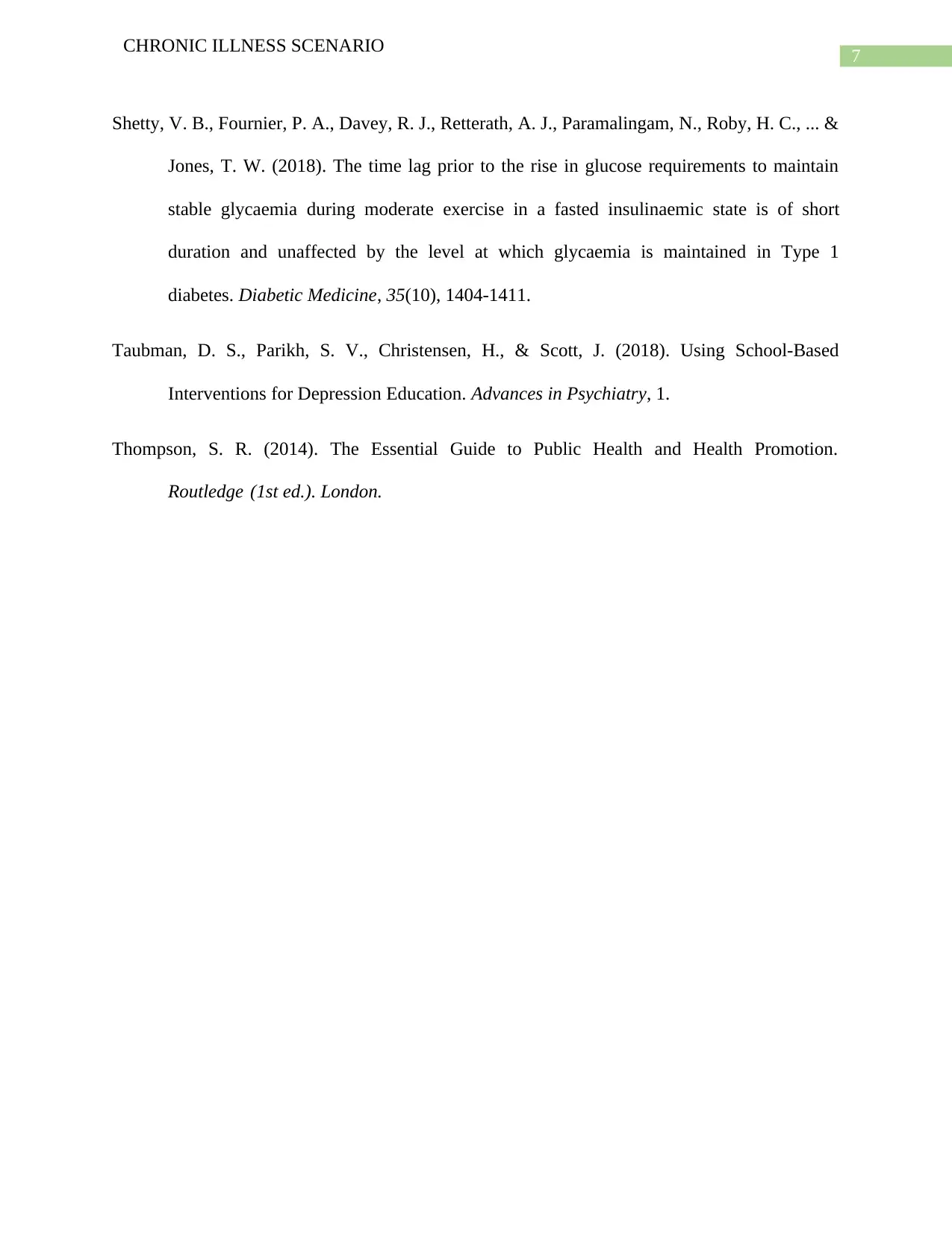
7
CHRONIC ILLNESS SCENARIO
Shetty, V. B., Fournier, P. A., Davey, R. J., Retterath, A. J., Paramalingam, N., Roby, H. C., ... &
Jones, T. W. (2018). The time lag prior to the rise in glucose requirements to maintain
stable glycaemia during moderate exercise in a fasted insulinaemic state is of short
duration and unaffected by the level at which glycaemia is maintained in Type 1
diabetes. Diabetic Medicine, 35(10), 1404-1411.
Taubman, D. S., Parikh, S. V., Christensen, H., & Scott, J. (2018). Using School-Based
Interventions for Depression Education. Advances in Psychiatry, 1.
Thompson, S. R. (2014). The Essential Guide to Public Health and Health Promotion.
Routledge (1st ed.). London.
CHRONIC ILLNESS SCENARIO
Shetty, V. B., Fournier, P. A., Davey, R. J., Retterath, A. J., Paramalingam, N., Roby, H. C., ... &
Jones, T. W. (2018). The time lag prior to the rise in glucose requirements to maintain
stable glycaemia during moderate exercise in a fasted insulinaemic state is of short
duration and unaffected by the level at which glycaemia is maintained in Type 1
diabetes. Diabetic Medicine, 35(10), 1404-1411.
Taubman, D. S., Parikh, S. V., Christensen, H., & Scott, J. (2018). Using School-Based
Interventions for Depression Education. Advances in Psychiatry, 1.
Thompson, S. R. (2014). The Essential Guide to Public Health and Health Promotion.
Routledge (1st ed.). London.
1 out of 8
Related Documents
Your All-in-One AI-Powered Toolkit for Academic Success.
+13062052269
info@desklib.com
Available 24*7 on WhatsApp / Email
![[object Object]](/_next/static/media/star-bottom.7253800d.svg)
Unlock your academic potential
© 2024 | Zucol Services PVT LTD | All rights reserved.





